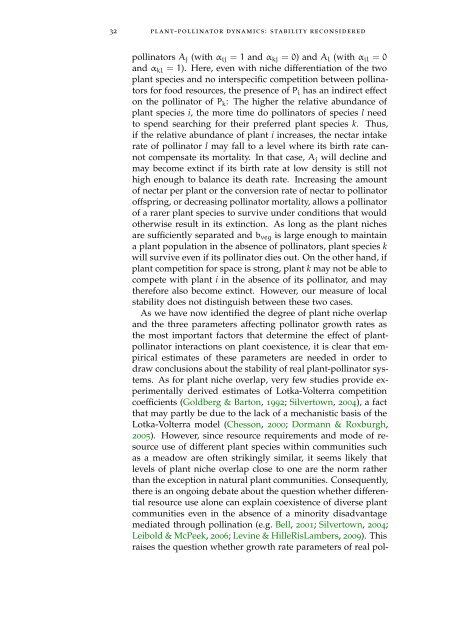Linking Specialisation and Stability of Plant ... - OPUS Würzburg
Linking Specialisation and Stability of Plant ... - OPUS Würzburg
Linking Specialisation and Stability of Plant ... - OPUS Würzburg
Create successful ePaper yourself
Turn your PDF publications into a flip-book with our unique Google optimized e-Paper software.
32 plant-pollinator dynamics: stability reconsidered<br />
pollinators A j (with α ij = 1 <strong>and</strong> α kj = 0) <strong>and</strong> A l (with α il = 0<br />
<strong>and</strong> α kl = 1). Here, even with niche differentiation <strong>of</strong> the two<br />
plant species <strong>and</strong> no interspecific competition between pollinators<br />
for food resources, the presence <strong>of</strong> P i has an indirect effect<br />
on the pollinator <strong>of</strong> P k : The higher the relative abundance <strong>of</strong><br />
plant species i, the more time do pollinators <strong>of</strong> species l need<br />
to spend searching for their preferred plant species k. Thus,<br />
if the relative abundance <strong>of</strong> plant i increases, the nectar intake<br />
rate <strong>of</strong> pollinator l may fall to a level where its birth rate cannot<br />
compensate its mortality. In that case, A j will decline <strong>and</strong><br />
may become extinct if its birth rate at low density is still not<br />
high enough to balance its death rate. Increasing the amount<br />
<strong>of</strong> nectar per plant or the conversion rate <strong>of</strong> nectar to pollinator<br />
<strong>of</strong>fspring, or decreasing pollinator mortality, allows a pollinator<br />
<strong>of</strong> a rarer plant species to survive under conditions that would<br />
otherwise result in its extinction. As long as the plant niches<br />
are sufficiently separated <strong>and</strong> b veg is large enough to maintain<br />
a plant population in the absence <strong>of</strong> pollinators, plant species k<br />
will survive even if its pollinator dies out. On the other h<strong>and</strong>, if<br />
plant competition for space is strong, plant k may not be able to<br />
compete with plant i in the absence <strong>of</strong> its pollinator, <strong>and</strong> may<br />
therefore also become extinct. However, our measure <strong>of</strong> local<br />
stability does not distinguish between these two cases.<br />
As we have now identified the degree <strong>of</strong> plant niche overlap<br />
<strong>and</strong> the three parameters affecting pollinator growth rates as<br />
the most important factors that determine the effect <strong>of</strong> plantpollinator<br />
interactions on plant coexistence, it is clear that empirical<br />
estimates <strong>of</strong> these parameters are needed in order to<br />
draw conclusions about the stability <strong>of</strong> real plant-pollinator systems.<br />
As for plant niche overlap, very few studies provide experimentally<br />
derived estimates <strong>of</strong> Lotka-Volterra competition<br />
coefficients (Goldberg & Barton, 1992; Silvertown, 2004), a fact<br />
that may partly be due to the lack <strong>of</strong> a mechanistic basis <strong>of</strong> the<br />
Lotka-Volterra model (Chesson, 2000; Dormann & Roxburgh,<br />
2005). However, since resource requirements <strong>and</strong> mode <strong>of</strong> resource<br />
use <strong>of</strong> different plant species within communities such<br />
as a meadow are <strong>of</strong>ten strikingly similar, it seems likely that<br />
levels <strong>of</strong> plant niche overlap close to one are the norm rather<br />
than the exception in natural plant communities. Consequently,<br />
there is an ongoing debate about the question whether differential<br />
resource use alone can explain coexistence <strong>of</strong> diverse plant<br />
communities even in the absence <strong>of</strong> a minority disadvantage<br />
mediated through pollination (e.g. Bell, 2001; Silvertown, 2004;<br />
Leibold & McPeek, 2006; Levine & HilleRisLambers, 2009). This<br />
raises the question whether growth rate parameters <strong>of</strong> real pol-
















